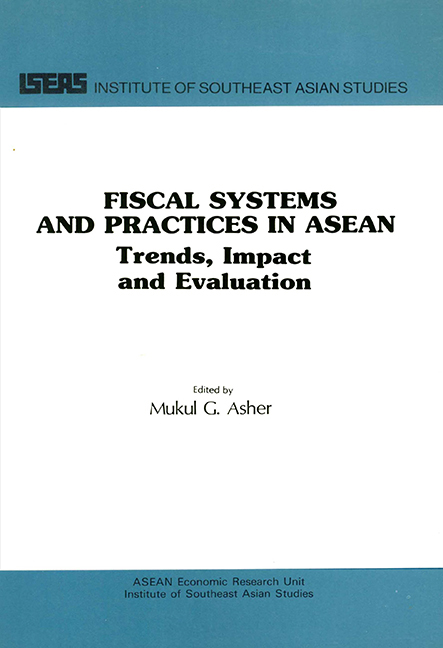Book contents
- Frontmatter
- Contents
- List of Tables
- List of Figures
- Acknowledgements
- 1 A Comparative Overview of ASEAN Fiscal Systems an Practices
- 2 Fiscal System and Practices in Indonesia
- 3 Fiscal System and Practices in Malaysia
- 4 Fiscal System and Practices in the Philippines
- 5 Fiscal System and Practices in Singapore
- 6 Fiscal System and Practices in Thailand
- THE EDITOR
5 - Fiscal System and Practices in Singapore
Published online by Cambridge University Press: 21 October 2015
- Frontmatter
- Contents
- List of Tables
- List of Figures
- Acknowledgements
- 1 A Comparative Overview of ASEAN Fiscal Systems an Practices
- 2 Fiscal System and Practices in Indonesia
- 3 Fiscal System and Practices in Malaysia
- 4 Fiscal System and Practices in the Philippines
- 5 Fiscal System and Practices in Singapore
- 6 Fiscal System and Practices in Thailand
- THE EDITOR
Summary
Introduction
From the public finance perspective, instruments available to a government in tackling its myriad tasks may be classified under three broad categories. These are fiscal or budgetary policies; policies concerning state or public enterprises; and policies affecting the social, political and economic environment. The last category includes government rules and regulations; governmental attitudes concerning industrial relations, foreign enterprises, public bureaucracy and the relationship between the individual and the state; and broad manpower policies.
The main objective of this paper is to provide an overview of Singapore's fiscal system and practices. While the focus is on the fiscal system and practices, to the extent that there are important interconnections between it and the other two broad categories noted above, they are incorporated in the analysis. The discussion includes an examination of the probable impact of Singapore's fiscal system and practices on resource allocation, equity, incentives to work, to save, and to invest, and macro-economic stability. The paucity of relevant and reliable empirical studies, and limitations of the existing economic theory have necessitated a reliance on a qualitative rather than a quantitative analysis.
Although this paper does not seek to provide a comprehensive analysis of the role of the fiscal system and practices in Singapore's rapid economic growth, it is hoped that a firm basis for such an analysis will have been provided.
The Budgetary System
Accounts of the Singapore Government are organized around various funds. Premchand identifies eight such funds, thus classifying Singapore as belonging to an Intermediate Fund System, that is, countries with 5 to 20 such funds (1983, pp. 393-95). Of the eight funds, only the Consolidated Fund, Development Fund, Sinking Funds, and Skills Development Fund (SDF) are of major importance. Funds which are of minor importance include Contingencies Fund and various Revolving Funds for meeting personal advances and housing and vehicle loans.
The Consolidated Fund consists of Consolidated Loan Account and Consolidated Revenue Account. All proceeds from loans are accounted for in the former, while all monies other than loan monies are accounted for by the latter.
Information
- Type
- Chapter
- Information
- Fiscal System and Practices in ASEANTrends, Impact and Evaluation, pp. 131 - 183Publisher: ISEAS–Yusof Ishak InstitutePrint publication year: 1989
